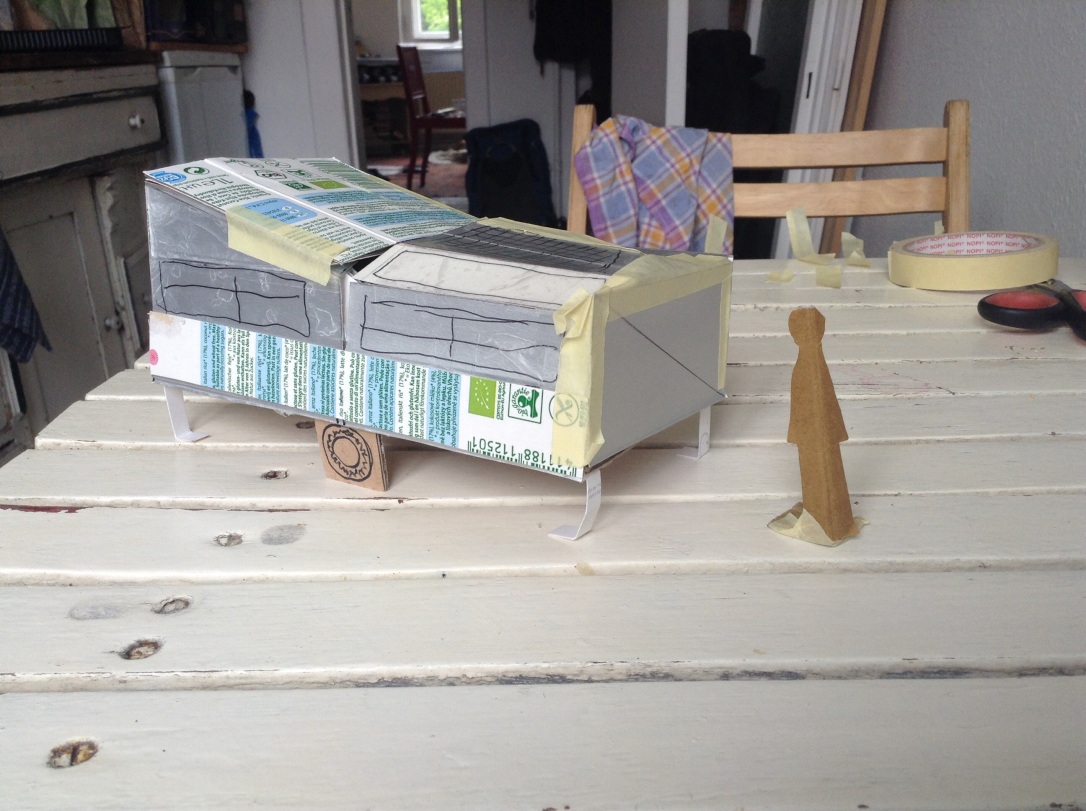I used to live in a treehouse in Berlin, but now I’ve got a family. The design brief for a good quality shelter and base for living has changed. The Mobile Hexahome will be our first prototype house, and is still very much a work in progress. If you want to keep up to date, please subscribe to our newsletter or check into this blog for updates.
At present we are in the early stages of prototyping, we’re hoping to develop the prototype to a stage we can live in it during POC21 whilst living with other makers at a castle in France – life is hard ;). The images shown are MK1. MK2. is underway, taller and simpler in design and assembly.
The Hexahome opens from a box trailer 4.8 m x 2.4 m to create a 40 – 45 sqm living space which is comfortable and fit for myself and 2 princesses ;).
 Mobile Hexahome – Unfolded Side View
Mobile Hexahome – Unfolded Side View
The Hexahome will feature a range of sustainable technologies, creating a luxurious space that shows that it’s possible to minimise our environmental footprint, whilst enjoying a good quality of life.
Because the Hexahome is based on Open Source Technologies, it will be possible to build your own, or customise the design to better suit your needs. The core design is based on the Hexayurt system designed by Vinay Gupta for refugees and disaster relief. It is widely used at Burning Man. It’s been a pleasure to build on Vinay’s work and borrow his brain for this project.
For the inside, there will be a composting toilet that will feed a Vermiculture compost bin and/or Biogas system to provide energy for cooking and/or for plant growth. This will also be used for our organic waste. One big challenge with this is pathogen destruction – AKA killing the bad stuff in the poop. To kill the bad stuff we’ll need to pasteurise the poop – so we’ll need to incorporate a hot box somewhere in the process. Again Vinay has some great insights on both natural heating, and efficient energy use. I believe my friend Amin’s Insulangel product could be hacked to monitor such systems remotely for peace of mind.
The Grey Water from washing will be used for feeding plants (we’ll use an appropriate detergent), and perhaps filtered back through the system (at least for washing). For indoor growing solutions I’m thinking of a series of these wheels – but to make them thinner, and use the wheels to distribute water to grow spaces in the gaps.
The shower will be solar heated, and I intend to hook up some solar panels and perhaps wind energy in the long term. In the even longer term I’d like to convert a classic car to electric power and use that to transport the house.
The idea with the Hexahome is that we can feel at home wherever we are, as we explore where we might want to settle – if indeed we do. On another level we hope to create a space that demonstrates that living in a way that benefits the environment and others is not only feasible, but desirable and accessible. However “Home” is more than a house, or a physical location. To be “Home” is to be around people who you feel comfortable with. So this unit is intended to be one design of many, each adapted to the needs of friends who will travel with us as a part of a larger ever shifting community.
If you like what we’re doing and want to keep up to date then please subscribe to our newsletter or drop us an email and introduce yourself.


When playing at The Big Chill Festival in 2002, i met two people who were running a camera obscura, http://www.amazingcameraobscura.co.uk/ They were travelling around the festival circuit with their families. Two couples with five children between them.
They were using a pair of geodesic dome frames. The rods were made from socketed hazel wood, with the connecter’s made from plumber’s pipe, that had been heated, flattened at one end, and drilled for the bolts+wingnuts, that were used to hold it together. Wrap one large tarpaulin round the frame for the body of the dome and another one for the roof.
The bit that you might be most interested in. They had furniture that was based on viking designs. (Yes, they’ve been making flat-pack furniture for centuries… :)) ) A double bed for each couple, and a set of bunk beds for the childrens. Easy to make,easy to transport, easy to assemble, easy to take-down, and with futons, very comfortable to sleep in. Varnished plywood held together with wedges and tusk-tenons. A civilised way to work the festie circuit with a family.
LikeLike
Very inspiring, Jay. Concerning the poo problem. Did you hear about this solution yet? http://www.peepoople.com/
LikeLike
Wonderful! Good luck guys.
I seem to spend an inordinate amount of time thinking about composting human waste and what the large scale and small scale infrastructure for it needs to be. Small scale – sustainable boat loos for tiny boat on-shore cruising as well as for Floating Village (https://www.dorftv.at/tags/floating-village) – human waste and freshwater supplies shouldn’t be combined. In both of those situations – maximum a 20L bucket over 2 weeks we were faced with the fact that there were no places to safely dispose / long term compost the poop.
Large scale – what infrastructure would need to change in urban areas for composting toilets to become widely used? Regardless of whether someone is in Perth, Los Angeles, Calcutta, Edinburgh or Linz – washing away human waste with freshwater is ridiculous.
BTW have you heard about Bristol’s poo bus? http://www.theguardian.com/uk-news/2015/mar/15/uk-first-poo-bio-bus-bristol-regular-service
LikeLike